This is a default text for your page '. Click above on edit this page' to modify. Be careful with the < and > signs.
You may include any references to papers as in: the use of JSmol in Proteopedia [1] or to the article describing Jmol [2] to the rescue.
Function
Mhp1 is a trans-membrane protein bellowing to the nucleobase-cation-symport-1 (NCS1) transporter family from Microbacterium liquefaciens.
A transporter effects the cellular uptake and release of a wide range of substances across biological membranes in all organisms. This is done by coupling the uphill movement of the substrate against its concentration gradient with the energetically favorable downhill gradient of a second substrate, often a proton or a cation. The kinetics and thermodynamics of the transporters can be explained by their alternating conformations.[doi: 10.1126/science.1186303]
In the case of Mhp1, it allows the sodium dependent income of indolyl methyl- and benzyl-hydantoins (Figure 1) in the cell. Those are part of a salvage metabolic pathway leading to their conversion in amino acids.
2JLN is one of the conformations of Mhp1. It is the outward-facing conformation without substrate.
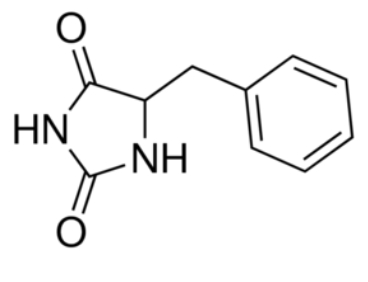
Figure 1 : Structure of benzyl-hydantoin, the substrate of Mhp1
Relevance
Disease
Dysfunction of members of the transporters family in humans can lead to diseases including neurological and kidney disorders. Other members are implicated in cancer as they can supply tumor cells with nutrients, cause drug resistance and/or provide a means of treatment.
[DOI 10.1126/science.1186303]
Structural highlights
Global structure
The protein is composed of one chain of 12 transmembrane alpha helices (TMs). They are organised in two repeating units connected by a 59-residue loop (TMs 1-5 and TMs 6-10) and two additional helices (TM 11 and 12). The two repeating units have a symmetrical topology (Figure 2).
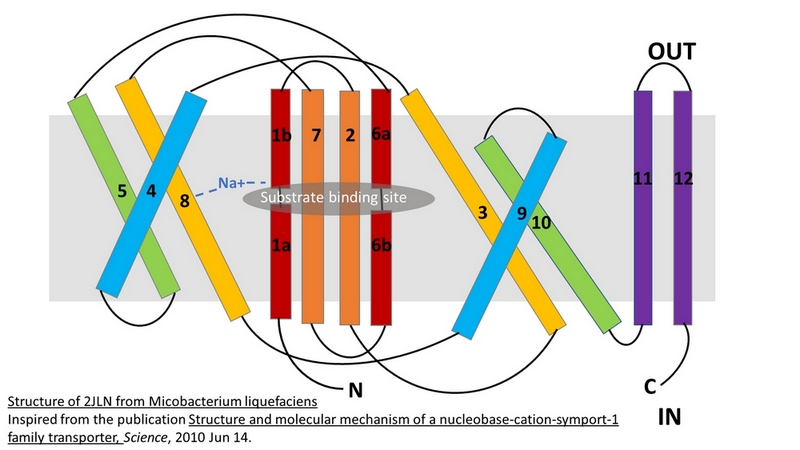
Figure 2 : Structure of Mhp1 from Microbacterum liquefaciens
The central bundle is composed of TMs 1 and 2, twined to the TMs 6 and 7 respectively. In addition, the protein presents a V-shape structure formed by TMs 3 to 5, twined to TMs 8 to 10 (Figure 2).
The substrate- and cation-binding sites are located in the space between the central four-helix-bundle and the outer helix layer.
Structure of the substrate binding site
The substrate binding site is located at the break of the TMs 1 and 6. (Figure 2)
The substrate, the benzyl-hydantoin interacts with the amino acids of the binding site. The hydantoin group establisches pi-stacking interactions with the indole ring of Trp 117 and Trp 220 and hydrogen bonds with Asn 318 and Gln 121. The benzyl ring interacts with Trp 220 and Gln 42 (Figure 3).
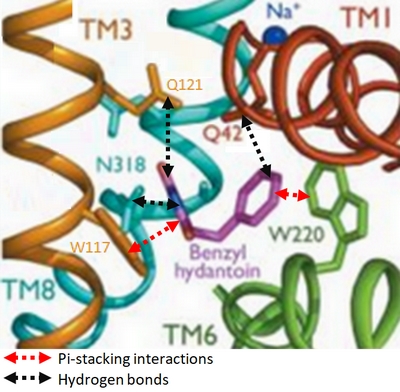
Figure 3 : Substrate binding site
Structure of the cation binding site
Mhp1 is a sodium dependent protein. The sodium binds at the C-terminal end of TM1a and interacts with TM8 (Figure 2). The dipole moment at the C-terminus of TM1a contributes to the binding.
Experiments have shown that benzyl-hydantoin increases the affinity of sodium for Mhp1 and reciprocally sodium increases the affinity of benzyl-hydantoin for Mhp1. Therefore, the binding of the substrate and the cation are closely coupled.
Conformational states
Mhp1 exists in two conformational states depending if the substrate is bound or not: the substrate free structure (-BH), corresponding to the outward-facing open and the substrate bound structure (+BH), corresponding to the outward-facing occluded (Figure 4).
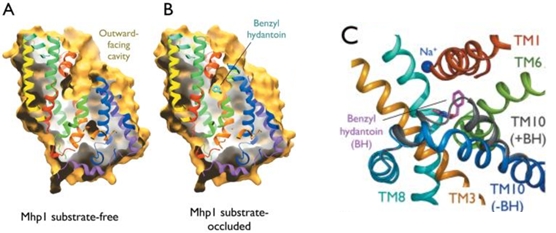
Figure 4: The conformational change upon the substrate binding
The binding of the substrate induces conformational changes of the protein allowing it uptake in the cell.
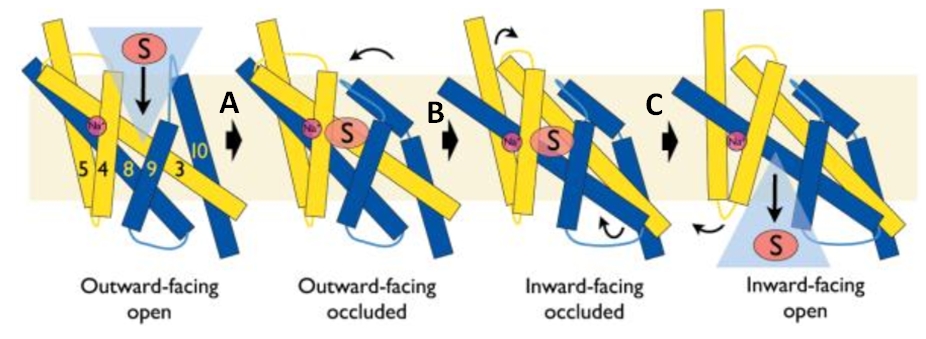
Figure 5 : Proposed substrate translocation mechanism by Mhp1
The binding of the substrate in the binding site leads to a switch from the outward-facing open state to the outward-facing occluded state. The TM10 arrangement changes (Figure 4.C) and closes the access to the “OUT” side space of the membrane (Figure 5.A).
Then, there is a change from the outward-facing occluded state to the inward-facing occluded state. (Figure 5.B) The substrate-binding site is occluded from the inside of the membrane. It seems that the movement involves the helix bundle of TMs 3 and 8. Moreover, researchers are working on the possibility of a coordinated shifting of TMs 1 and 6 shift with TMs 3 and 8.
Eventually, there is a switch from the inward-facing occluded state to the inward-facing open state. This allows the release of the substrate in the cytoplasm. However, the structures involved in the change still be unclear (Figure 5.C).
This is a sample scene created with SAT to by Group, and another to make of the protein. You can make your own scenes on SAT starting from scratch or loading and editing one of these sample scenes.





